RT9193
300mA, Ultra-Low Noise, Ultra-Fast CMOS LDO Regulator
General Description
The RT9193 is designed for portable RF and wireless
applications with demanding performance and space
requirements. The RT9193 performance is optimized for
battery-powered systems to deliver ultra low noise and
low quiescent current. A noise bypass pin is available for
further reduction of output noise. Regulator ground current
increases only slightly in dropout, further prolonging the
battery life. The RT9193 also works with low-ESR ceramic
capacitors, reducing the amount of board space necessary
for power applications, critical in hand-held wireless
devices. The RT9193 consumes less than 0.01μA in
shutdown mode and has fast turn-on time less than 50μs.
The other features include ultra low dropout voltage, high
output accuracy, current limiting protection, and high ripple
rejection ratio. Available in the 5-lead of SC-70, SOT-23
and WDFN-6L 2x2 packages.
Features
Ultra-Low-Noise for RF Application
Ultra-Fast Response in Line/Load Transient
Quick Start-Up (Typically 50μμμμμs)
< 0.01μμμμμA Standby Current When Shutdown
Low Dropout : 220mV @ 300mA
Wide Operating Voltage Ranges : 2.5V to 5.5V
TTL-Logic-Controlled Shutdown Input
Low Temperature Coefficient
Current Limiting Protection
Thermal Shutdown Protection
Only 1μμμμμF Output Capacitor Required for Stability
High Power Supply Rejection Ratio
Custom Voltage Available
RoHS Compliant and 100% Lead (Pb)-Free
Applications
CDMA/GSM Cellular Handsets
Battery-Powered Equipment
Laptop, Palmtops, Notebook Computers
Hand-Held Instruments
PCMCIA Cards
Portable Information Appliances
Ordering Information
RT9193-
Package Type
U5 : SC-70-5
B : SOT-23-5
QW : WDFN-6L 2x2 (W-Type)
Operating Temperature Range
P : Pb Free with Commercial Standard
G : Green (Halogen Free with Commer-
cial Standard)
Output Voltage
15 : 1.5V
16 : 1.6V
:
49 : 4.9V
50 : 5.0V
1H : 1.85V
2H : 2.85V
4G : 4.75V
Note :
RichTek Pb-free and Green products are :
RoHS compliant and compatible with the current require-
ments of IPC/JEDEC J-STD-020.
Suitable for use in SnPb or Pb-free soldering processes.
100% matte tin (Sn) plating.
DS9193-09 March 2007
Marking Information
For marking information, contact our sales representative
directly or through a RichTek distributor located in your
area, otherwise visit our website for detail.
Pin Configurations
(TOP VIEW)
VIN
GND
EN
1
2
3
5
4
VOUT
BP
EN
GND
VIN
1
2
3
6
5
4
BP
NC
VOUT
SC-70-5/SOT-23-5
WDFN-6L 2x2
www.richtek.com
1
�
RT9193
Typical Application Circuit
VIN
CIN
1uF/X7R
RT9193
VOUT
VIN
GND
Chip Enable
EN
BP
VOUT
COUT
1uF/X7R
CBP
22nF
Functional Pin Description
Pin Name Pin Function
EN
BP
GND
VOUT
VIN
Chip Enable (Active High). Note that this pin is high impedance. There should be a pull low 100kΩ
resistor connected to GND when the control signal is floating.
Reference Noise Bypass
Ground
Output Voltage
Power Input Voltage
Function Block Diagram
EN
BP
Quick
Start
VREF
Shutdown
and
Logic Control
+
-
Error
Amplifier
MOS Driver
Current-Limit
and
Thermal
Protection
VIN
VOUT
GND
www.richtek.com
2
DS9193-09 March 2007
�
Absolute Maximum Ratings (Note 1)
Supply Input Voltage------------------------------------------------------------------------------------------------------ 6V
Power Dissipation, PD @ TA = 25°C
SC-70-5 ---------------------------------------------------------------------------------------------------------------------- 300mW
SOT-23-5 -------------------------------------------------------------------------------------------------------------------- 400mW
WDFN-6L 2x2 -------------------------------------------------------------------------------------------------------------- 606mW
RT9193
Package Thermal Resistance (Note 4)
SOT-70-5, θJA --------------------------------------------------------------------------------------------------------------- 333°C/W
SOT-23-5, θJA --------------------------------------------------------------------------------------------------------------- 250°C/W
WDFN-6L 2x2, θJA --------------------------------------------------------------------------------------------------------- 165°C/W
Junction Temperature ----------------------------------------------------------------------------------------------------- 150°C
Lead Temperature (Soldering, 10 sec.) ------------------------------------------------------------------------------- 260°C
Storage Temperature Range -------------------------------------------------------------------------------------------- −65°C to 150°C
ESD Susceptibility (Note 2)
HBM (Human Body Mode) ---------------------------------------------------------------------------------------------- 2kV
MM (Machine Mode) ------------------------------------------------------------------------------------------------------ 200V
Recommended Operating Conditions (Note 3)
Supply Input Voltage------------------------------------------------------------------------------------------------------ 2.5V to 5.5V
EN Input Voltage ----------------------------------------------------------------------------------------------------------- 0V to 5.5V
Junction Temperature Range--------------------------------------------------------------------------------------------
Ambient Temperature Range--------------------------------------------------------------------------------------------
Electrical Characteristics
(VIN = VOUT + 1V, CIN = COUT = 1μF, CBP = 22nF, TA = 25°C, unless otherwise specified)
−40°C to 125°C
−40°C to 85°C
Parameter
Output Voltage Accuracy
Current Limit
Quiescent Current
Dropout Voltage (Note 5)
Line Regulation
Load Regulation
Standby Current
EN Input Bias Current
EN Threshold
Logic-Low Voltage VIL
Logic-High Voltage VIH
Output Noise Voltage
eNO
Power Supply
Rejection Rate
Thermal Shutdown Temperature
f = 100Hz
f = 10kHz
PSRR COUT = 1μF, IOUT = 10mA
TSD
DS9193-09 March 2007
Symbol
ΔVOUT
ILIM
IQ
VDROP
ΔVLINE
Test Conditions
IOUT = 1mA
RLOAD = 1Ω
VEN ≥ 1.2V, IOUT = 0mA
IOUT = 200mA, VOUT > 2.8V
IOUT = 300mA, VOUT > 2.8V
VIN = (VOUT + 1V) to 5.5V,
IOUT = 1mA
ΔVLOAD 1mA < IOUT < 300mA
ISTBY
IIBSD
VEN = GND, Shutdown
VEN = GND or VIN
VIN = 3V to 5.5V, Shutdown
VIN = 3V to 5.5V, Start-Up
10Hz to 100kHz, IOUT = 200mA
COUT = 1μF
Min
−2
360
--
--
--
--
--
--
--
1.2
--
--
--
--
Typ Max Units
--
400
90
170
220
+2
--
130
200
300
%
mA
μA
mV
--
--
0.01
0
--
--
100
−70
−50
165
0.3
0.6
1
100
0.4
--
--
--
--
--
%
%
μA
nA
V
μVRMS
dB
°C
To be continued
www.richtek.com
3
�
RT9193
Parameter
Symbol
Test Conditions
Min
Typ Max Units
Thermal Shutdown Temperature
Hysteresis
ΔTSD
--
30
--
°C
Note 1. Stresses listed as the above "Absolute Maximum Ratings" may cause permanent damage to the device. These are for
stress ratings. Functional operation of the device at these or any other conditions beyond those indicated in the
operational sections of the specifications is not implied. Exposure to absolute maximum rating conditions for extended
periods may remain possibility to affect device reliability.
Note 2. Devices are ESD sensitive. Handling precaution recommended.
Note 3. The device is not guaranteed to function outside its operating conditions.
Note 4. θJA is measured in the natural convection at TA = 25°C on a low effective thermal conductivity test board
(Single Layer, 1S) of JEDEC 51-3 thermal measurement standard.
Note 5. The dropout voltage is defined as VIN -VOUT, which is measured when VOUT is VOUT(NORMAL) − 100mV.
www.richtek.com
4
DS9193-09 March 2007
�
Typical Operating Characteristics
Output Voltage vs. Temperature
RT9193-15CU5
VIN = 3.3V
CIN = COUT = 1uF X7R
RT9193
Quiescent Current vs. Temperature
RT9193-15CU5
VIN = 3.3V
CIN = COUT = 1uF X7R
)
A
u
(
t
n
e
r
r
u
C
t
n
e
c
s
e
u
Q
i
95
90
85
80
75
70
65
60
1.8
1.7
1.6
1.5
1.4
1.3
1.2
300
250
200
150
100
50
0
1.5
1.25
1
0.75
0.5
)
V
(
e
g
a
t
l
o
V
t
u
p
t
u
O
)
V
m
(
e
g
a
t
l
o
V
t
u
o
p
o
r
D
)
V
l
(
d
o
h
s
e
r
h
T
n
w
o
d
t
u
o
h
S
n
P
N
E
i
-50
-25
25
50
0
(°C)
Temperature
75
100
125
-50
-25
25
50
0
(°C)
Temperature
75
100
125
Dropout Voltage vs. Load Current
RT9193-33CB
CIN = COUT = 1uF
TJ = 125°C
TJ = 25°C
TJ = -40°C
0
0.05
0.15
0.1
0.2
Load Current (A)
0.25
0.3
)
B
d
(
R
R
S
P
20
0
-20
-40
-60
-80
PSRR
VIN = 4V to 5V
CIN = COUT = 1uF, X7R
ILoad = 100mA
ILoad = 10mA
10
0.01
100
0.1
1K
1
10K
10
Frequency (kHz)
(Hz)
100K
100
1M
1000
EN Pin Shoutdown Threshold vs. Temperature
1.75
RT9193-15CU5
VIN = 3.3V
CIN = COUT = 1uF X7R
EN Pin Shutdown Response
VIN = 5V
CIN = COUT = 1uF
RT9193-28CU5
No Load
10
5
0
2
1
0
e
g
a
t
l
o
V
n
P
N
E
i
)
V
(
e
g
a
t
l
o
V
t
u
p
t
u
O
)
V
(
25
0
Temperature
50
(°C)
-50
-25
DS9193-09 March 2007
75
100
125
Time (500μs/Div)
www.richtek.com
5
�
RT9193
Load Transient Response
VIN = 5V, VOUT = 2.8V
CIN = COUT = 1uF
ILoad = 1mA to 60mA
t
n
e
r
r
u
C
d
a
o
L
)
A
m
(
e
g
a
t
l
o
V
t
)
V
m
(
n
o
i
t
t
u
p
u
O
i
a
v
e
D
Load Transient Response
VIN = 5V, VOUT = 2.8V
CIN = COUT = 1uF
ILoad = 1mA to 250mA
400
200
0
50
0
-50
t
n
e
r
r
u
C
d
a
o
L
)
A
m
(
e
g
a
t
l
o
V
t
)
V
m
(
n
o
i
t
t
u
p
u
O
i
a
v
e
D
e
g
a
t
l
o
V
)
V
(
n
o
i
t
t
u
p
n
I
i
a
v
e
D
e
g
a
t
l
o
V
t
)
V
m
(
n
o
i
t
t
u
p
u
O
i
a
v
e
D
100
50
0
20
0
-20
6
5
4
10
0
-10
Time (500μs/Div)
Time (500μs/Div)
Line Transient Response
VIN = 4V to 5V
COUT = 1uF
RT9193-25CB
ILoad = 1mA
e
g
a
t
l
o
V
)
V
(
n
o
i
t
t
u
p
n
I
i
a
v
e
D
e
g
a
t
l
o
V
t
)
V
m
(
n
o
i
t
t
u
p
u
O
i
a
v
e
D
Line Transient Response
VIN = 4V to 5V
COUT = 1uF
RT9193-25CB
ILoad = 100mA
6
5
4
10
0
-10
Time (50μs/Div)
Noise
Time (100μs/Div)
Noise
VIN = 4.5V
CIN = COUT = 1uF, X7R
RT9193-30CB
ILoad = 50mA
VIN = 4.5V
CIN = COUT = 1uF, X7R
RT9193-15CU5
ILoad = 50mA
200
100
0
-100
-200
)
V
μ
(
e
s
o
N
i
200
100
0
-100
-200
)
V
μ
(
e
s
o
N
i
f = 10Hz to 100kHz
Time (10ms/Div)
f = 10Hz to 100kHz
Time (10ms/Div)
www.richtek.com
6
DS9193-09 March 2007
�
RT9193
Start Up
VIN = 5V
CIN = COUT = 1uF
RT9193-28CU5
No Load
10
5
0
2
1
0
Time (10μs/Div)
e
g
a
t
l
i
o
V
n
P
N
E
)
V
(
e
g
a
t
l
o
V
t
t
u
p
u
O
)
V
(
DS9193-09 March 2007
www.richtek.com
7
�
RT9193
Applications Information
Like any low-dropout regulator, the external capacitors
used with the RT9193 must be carefully selected for
regulator stability and performance. Using a capacitor
whose value is > 1μF on the RT9193 input and the amount
of capacitance can be increased without limit. The input
capacitor must be located a distance of not more than
0.5 inch from the input pin of the IC and returned to a
clean analog ground. Any good quality ceramic or
tantalum can be used for this capacitor. The capacitor
with larger value and lower ESR (equivalent series
resistance) provides better PSRR and line-transient
response. The output capacitor must meet both
requirements for minimum amount of capacitance and
ESR in all LDOs application. The RT9193 is designed
specifically to work with low ESR ceramic output capacitor
in space-saving and performance consideration. Using
a ceramic capacitor whose value is at least 1μF with ESR
is > 25mΩ on the RT9193 output ensures stability. The
RT9193 still works well with output capacitor of other
types due to the wide stable ESR range. Figure 1 shows
the curves of allowable ESR range as a function of load
current for various output capacitor values. Output
capacitor of larger capacitance can reduce noise and
improve load transient response, stability, and PSRR. The
output capacitor should be located not more than 0.5
inch from the VOUT pin of the RT9193 and returned to a
clean analog ground.
Region of Stable COUT ESR vs. Load Current
100.00
100
)
Ω
(
R
S
E
T
U
O
C
10
10.00
1
1.00
0.10
0.01
0.00
Instable
Stable
Simulation Verify
RT9193-15CU5
CIN = COUT = 1uF, X7R
0
50
150
100
200
Load Current (mA)
250
300
Figure 1
Bypass Capacitor and Low Noise
Connecting a 22nF between the BP pin and GND pin
significantly reduces noise on the regulator output, it is
critical that the capacitor connection between the BP pin
and GND pin be direct and PCB traces should be as short
as possible. There is a relationship between the bypass
capacitor value and the LDO regulator turn on time. DC
leakage on this pin can affect the LDO regulator output
noise and voltage regulation performance.
Enable Function
The RT9193 features an LDO regulator enable/disable
function. To assure the LDO regulator will switch on, the
EN turn on control level must be greater than 1.2 volts.
The LDO regulator will go into the shutdown mode when
the voltage on the EN pin falls below 0.4 volts. For to
protecting the system, the RT9193 have a quick-discharge
function. If the enable function is not needed in a specific
application, it may be tied to VIN to keep the LDO regulator
in a continuously on state.
Thermal Considerations
Thermal protection limits power dissipation in RT9193.
When the operation junction temperature exceeds 165°C,
the OTP circuit starts the thermal shutdown function turn
the pass element off. The pass element turn on again
after the junction temperature cools by 30°C.
For continue operation, do not exceed absolute maximum
operation junction temperature 125°C. The power
dissipation definition in device is :
PD = (VIN−VOUT) x IOUT + VIN x IQ
The maximum power dissipation depends on the thermal
resistance of IC package, PCB layout, the rate of
surroundings airflow and temperature difference between
junction to ambient. The maximum power dissipation can
be calculated by following formula :
PD(MAX) = ( TJ(MAX) − TA ) /θJA
Where TJ(MAX) is the maximum operation junction
temperature 125°C, TA is the ambient temperature and
the θJA is the junction to ambient thermal resistance.
www.richtek.com
8
DS9193-09 March 2007
�


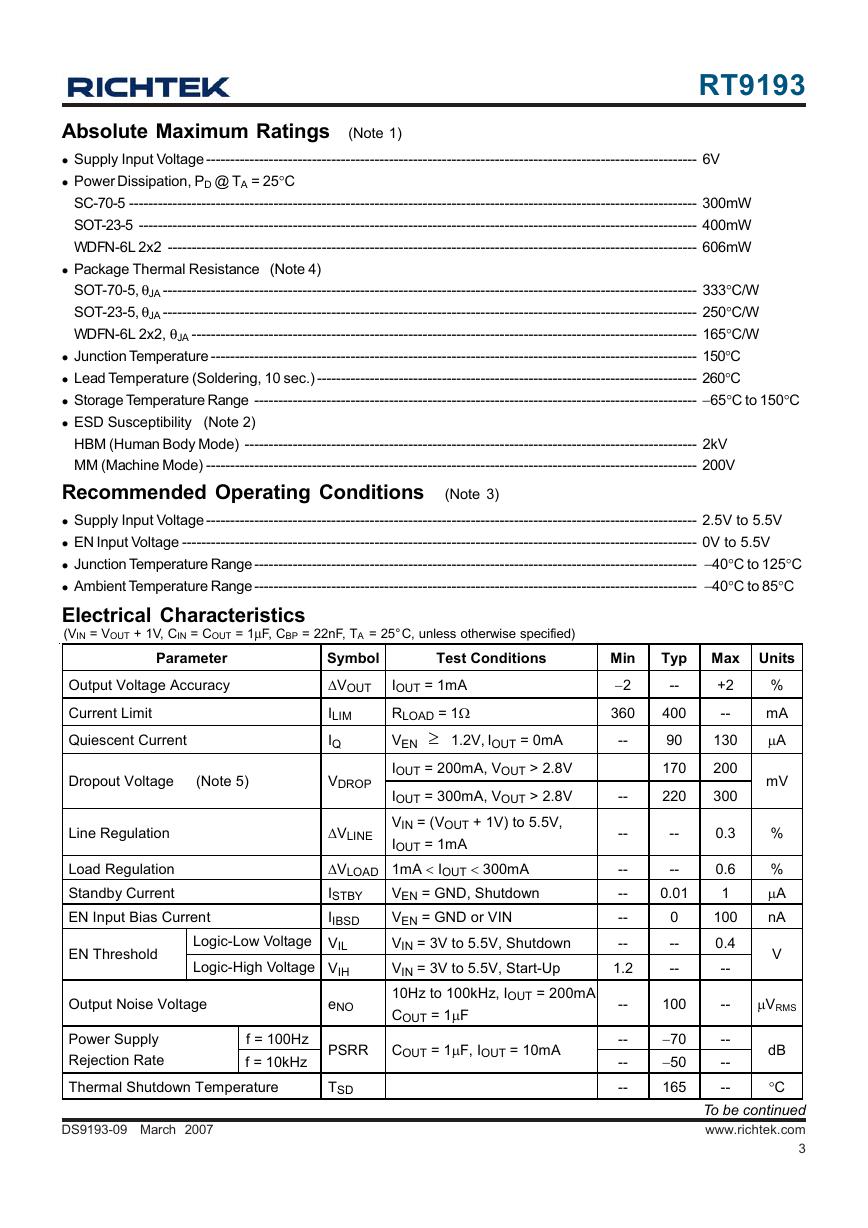
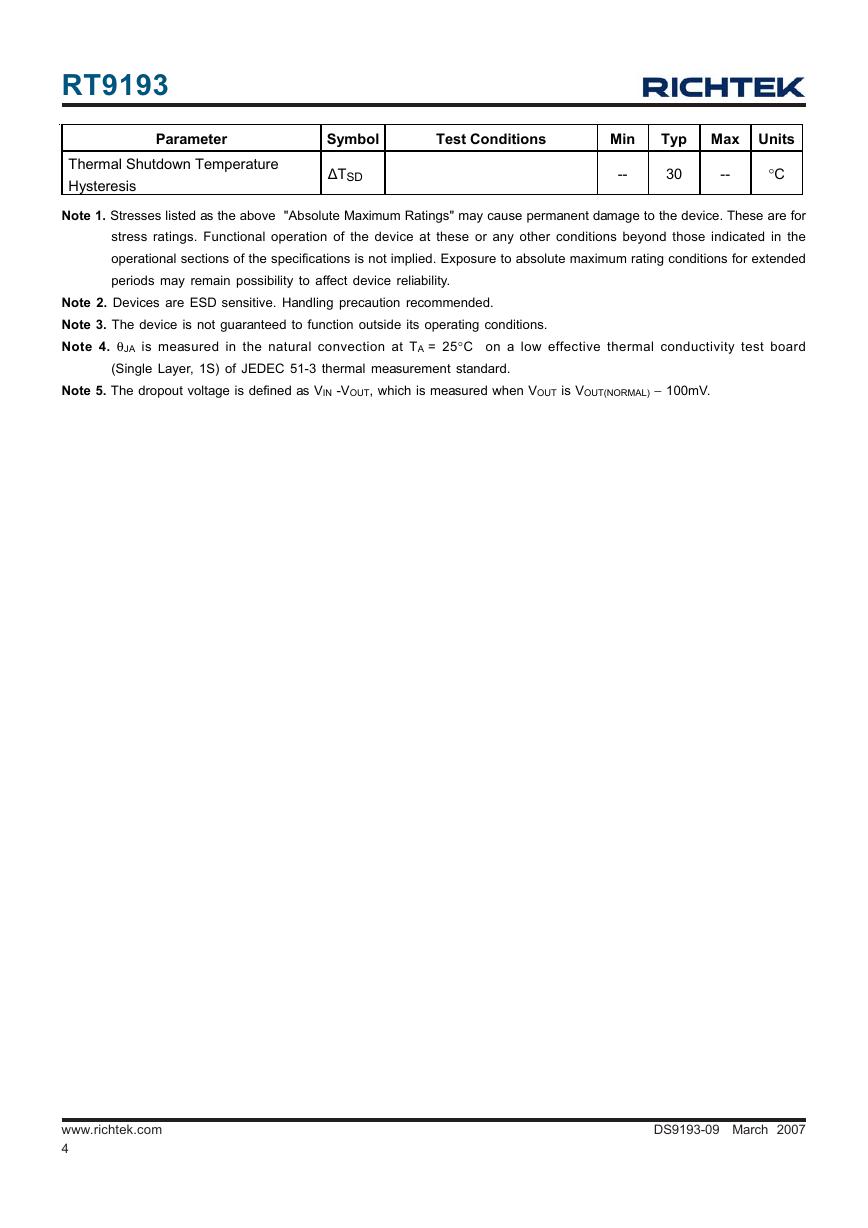

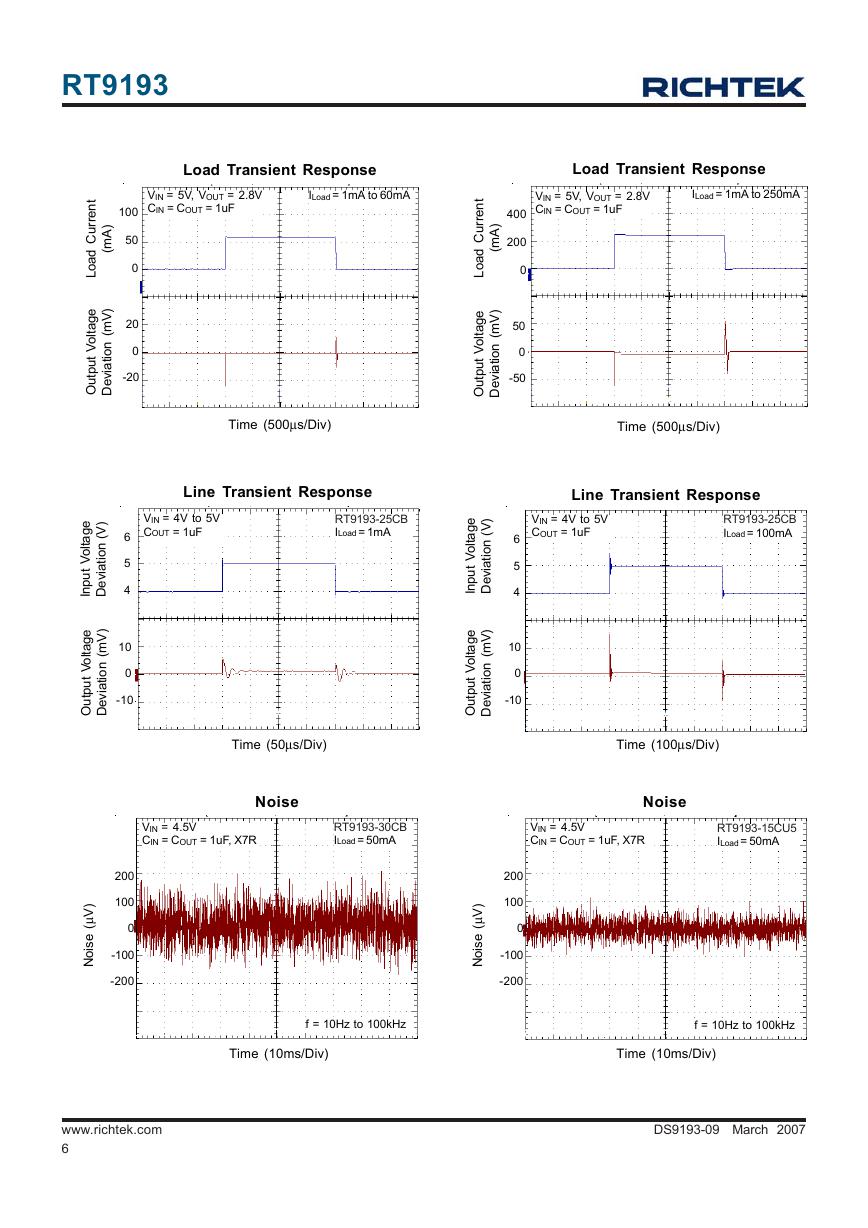
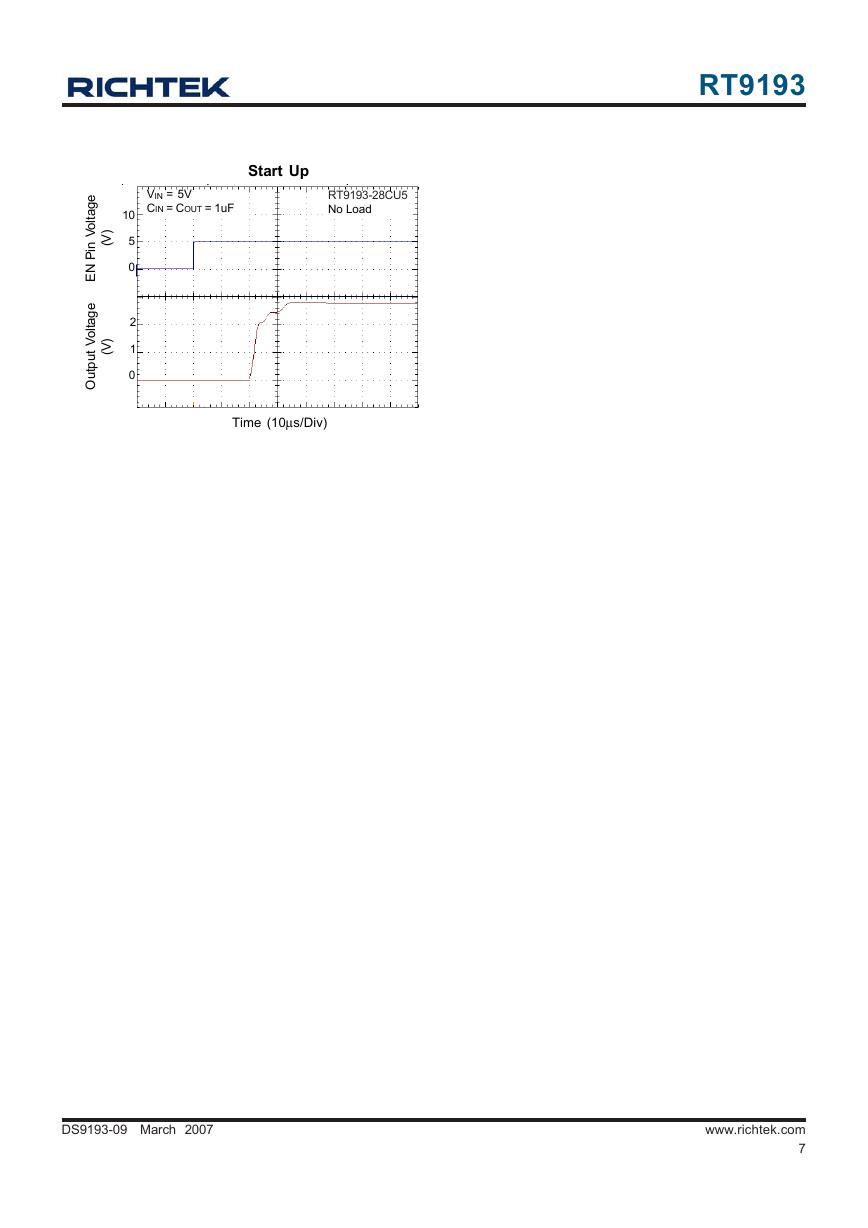
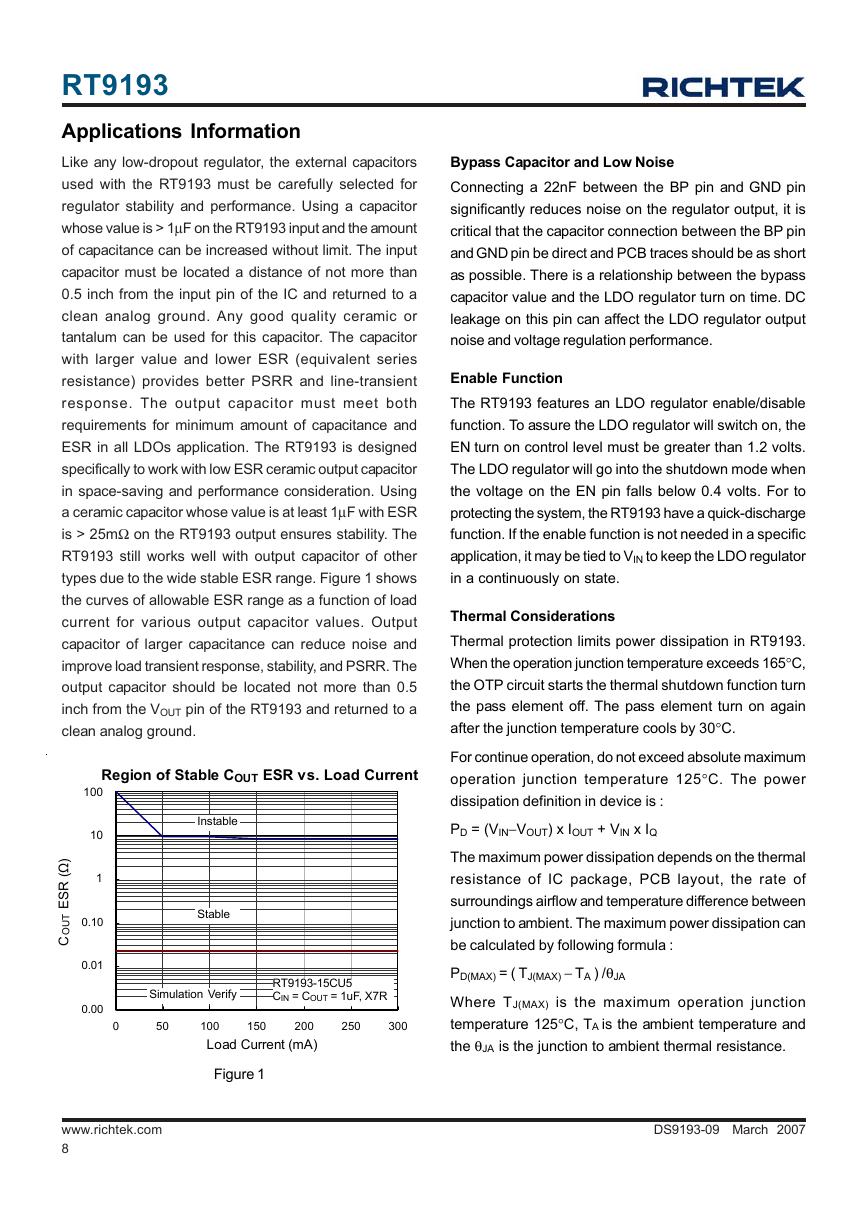








 V2版本原理图(Capacitive-Fingerprint-Reader-Schematic_V2).pdf
V2版本原理图(Capacitive-Fingerprint-Reader-Schematic_V2).pdf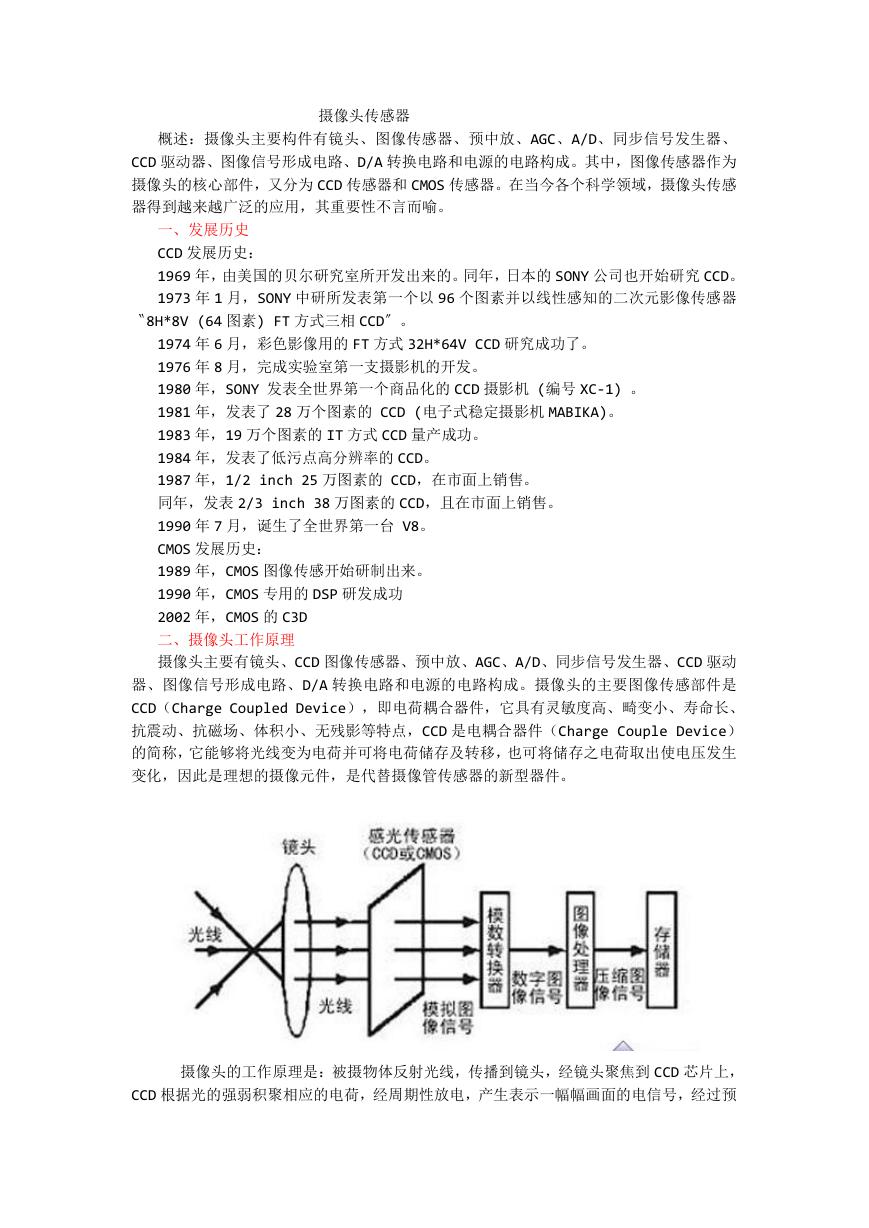 摄像头工作原理.doc
摄像头工作原理.doc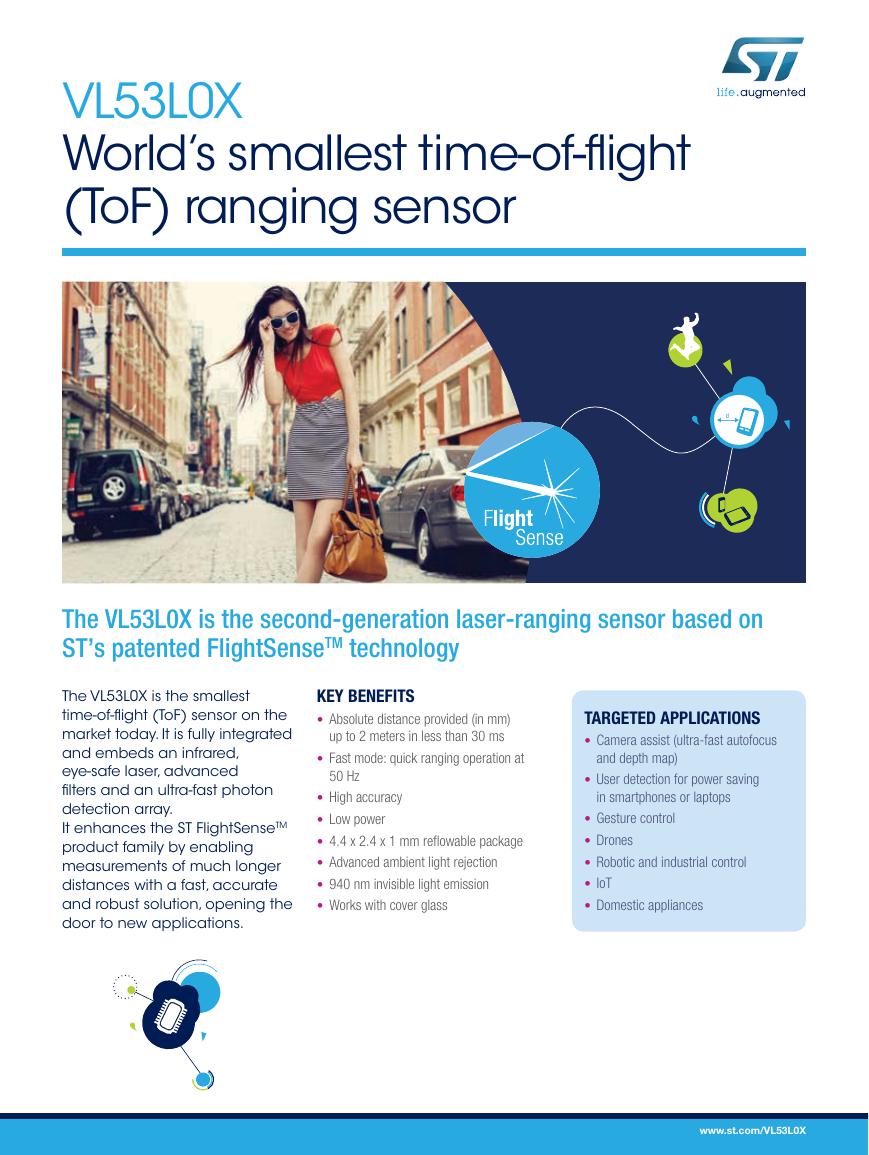 VL53L0X简要说明(En.FLVL53L00216).pdf
VL53L0X简要说明(En.FLVL53L00216).pdf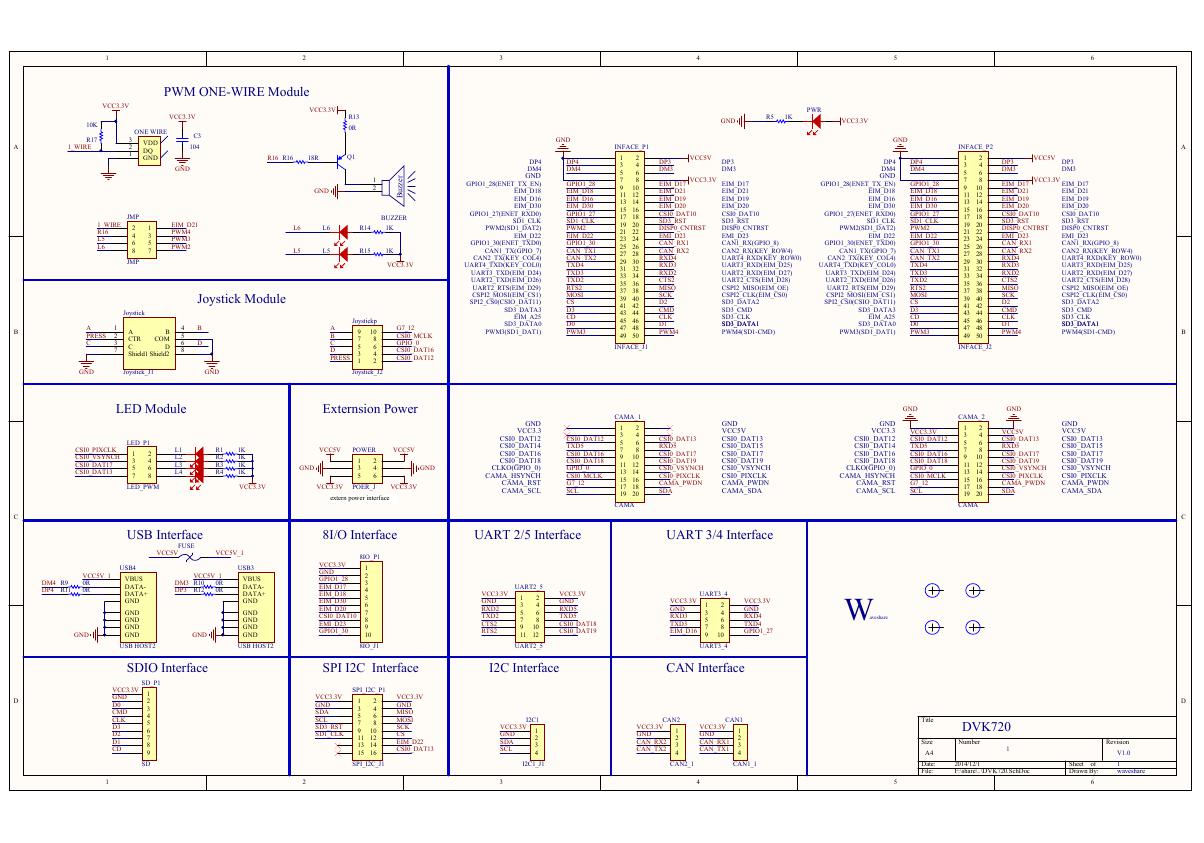 原理图(DVK720-Schematic).pdf
原理图(DVK720-Schematic).pdf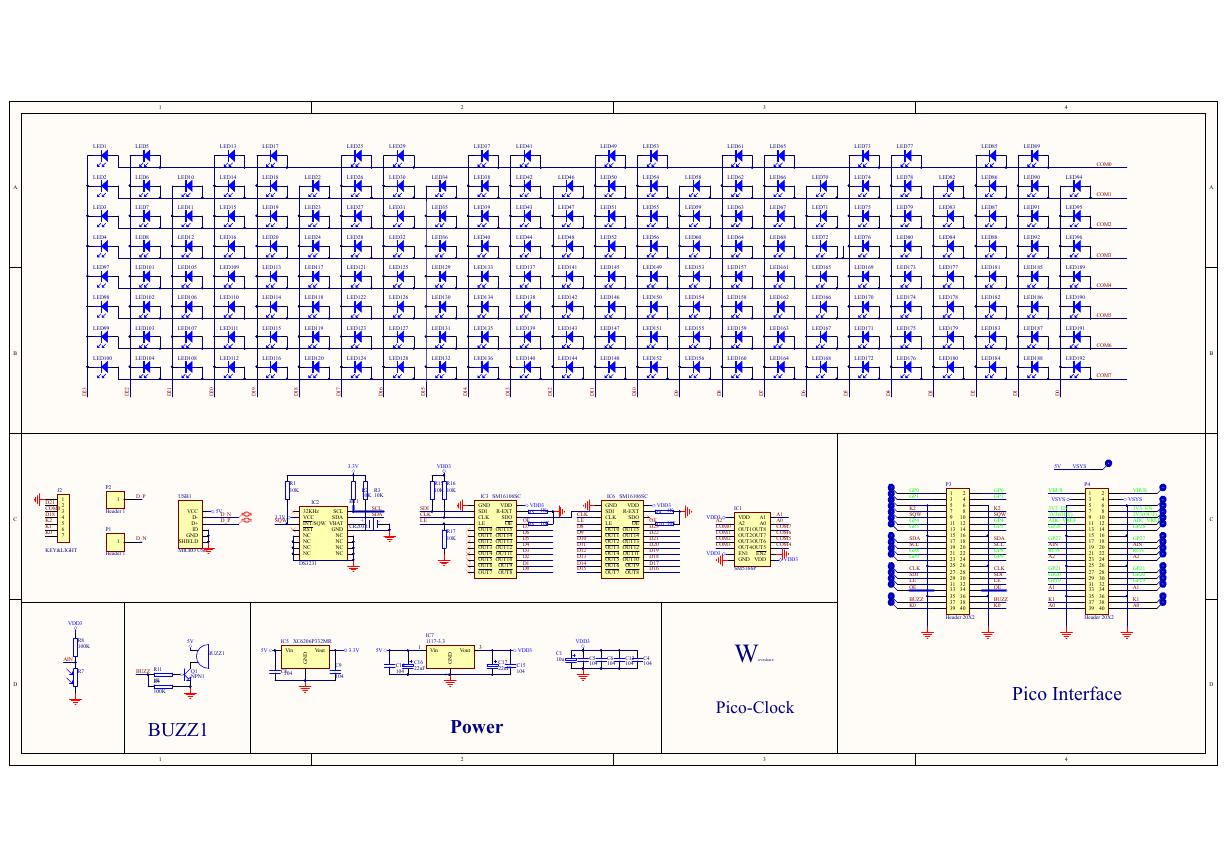 原理图(Pico-Clock-Green-Schdoc).pdf
原理图(Pico-Clock-Green-Schdoc).pdf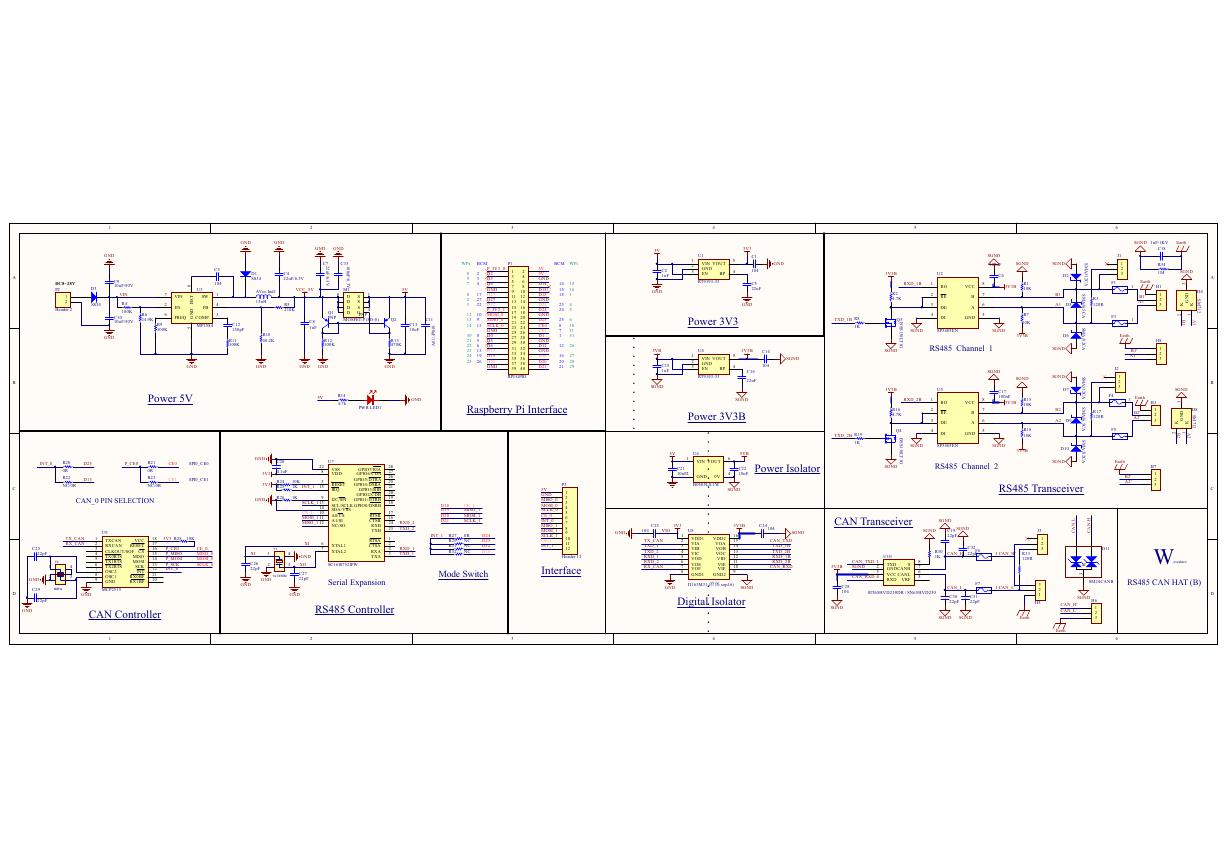 原理图(RS485-CAN-HAT-B-schematic).pdf
原理图(RS485-CAN-HAT-B-schematic).pdf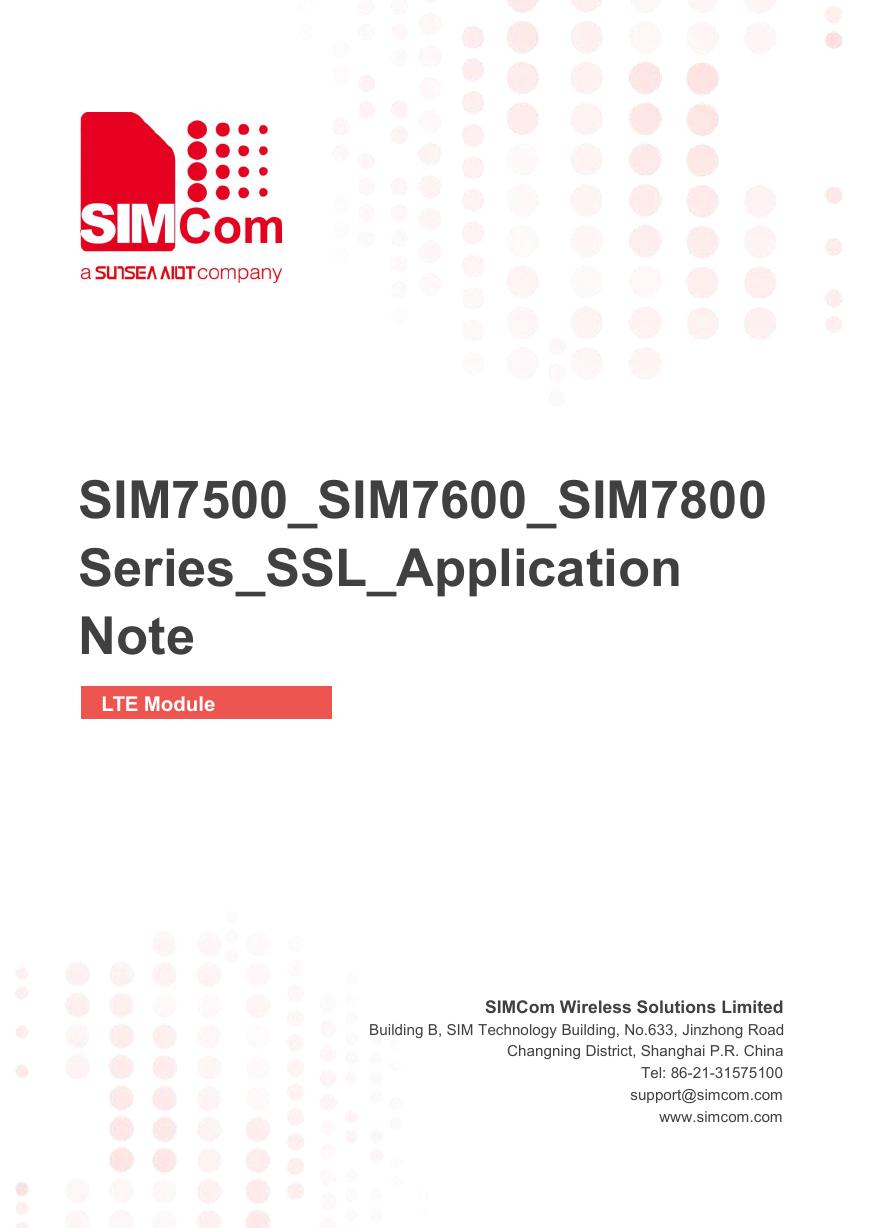 File:SIM7500_SIM7600_SIM7800 Series_SSL_Application Note_V2.00.pdf
File:SIM7500_SIM7600_SIM7800 Series_SSL_Application Note_V2.00.pdf ADS1263(Ads1262).pdf
ADS1263(Ads1262).pdf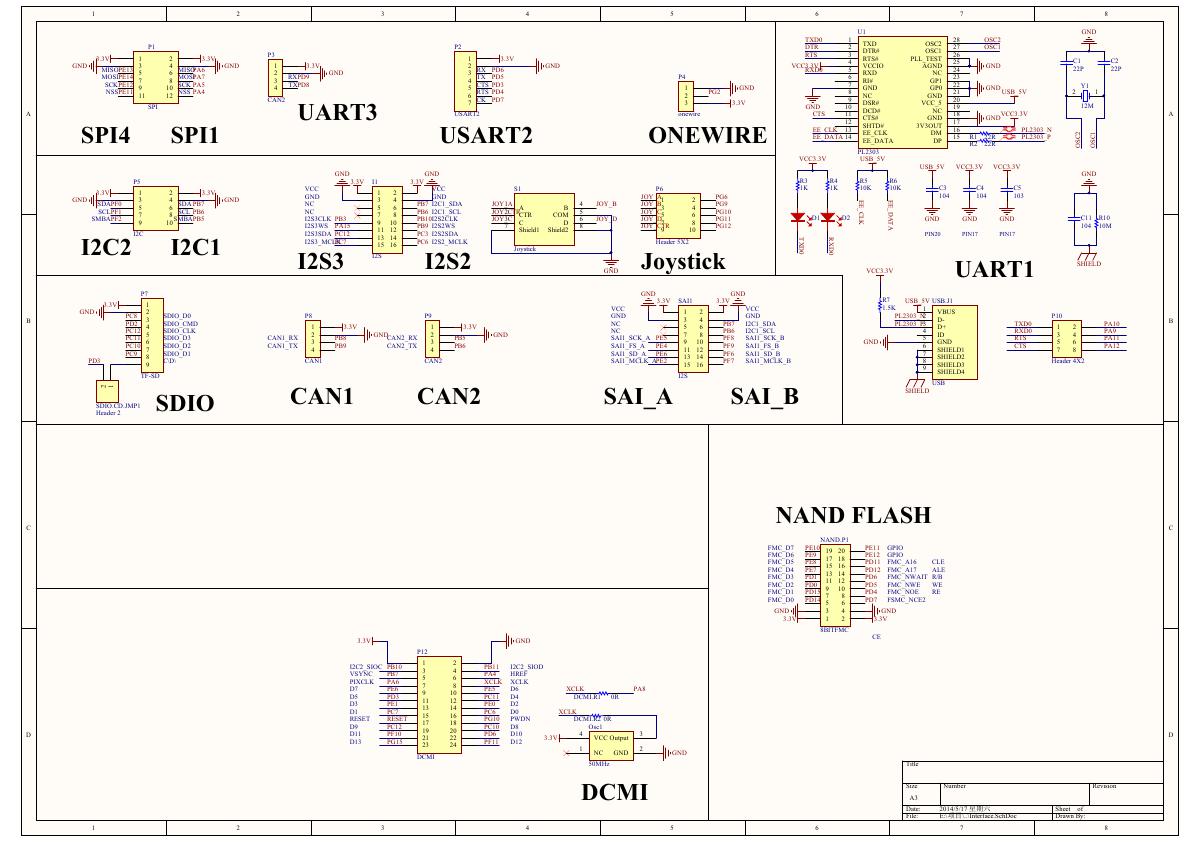 原理图(Open429Z-D-Schematic).pdf
原理图(Open429Z-D-Schematic).pdf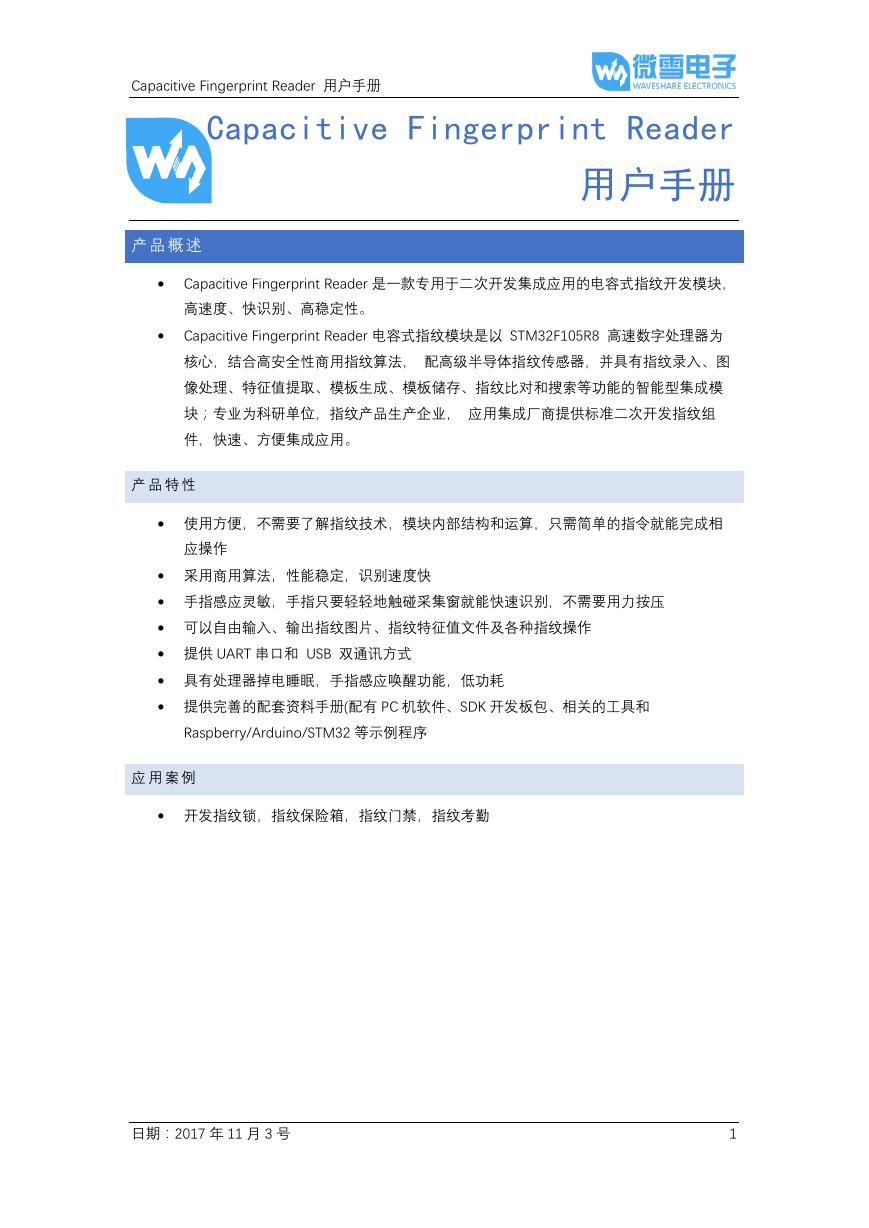 用户手册(Capacitive_Fingerprint_Reader_User_Manual_CN).pdf
用户手册(Capacitive_Fingerprint_Reader_User_Manual_CN).pdf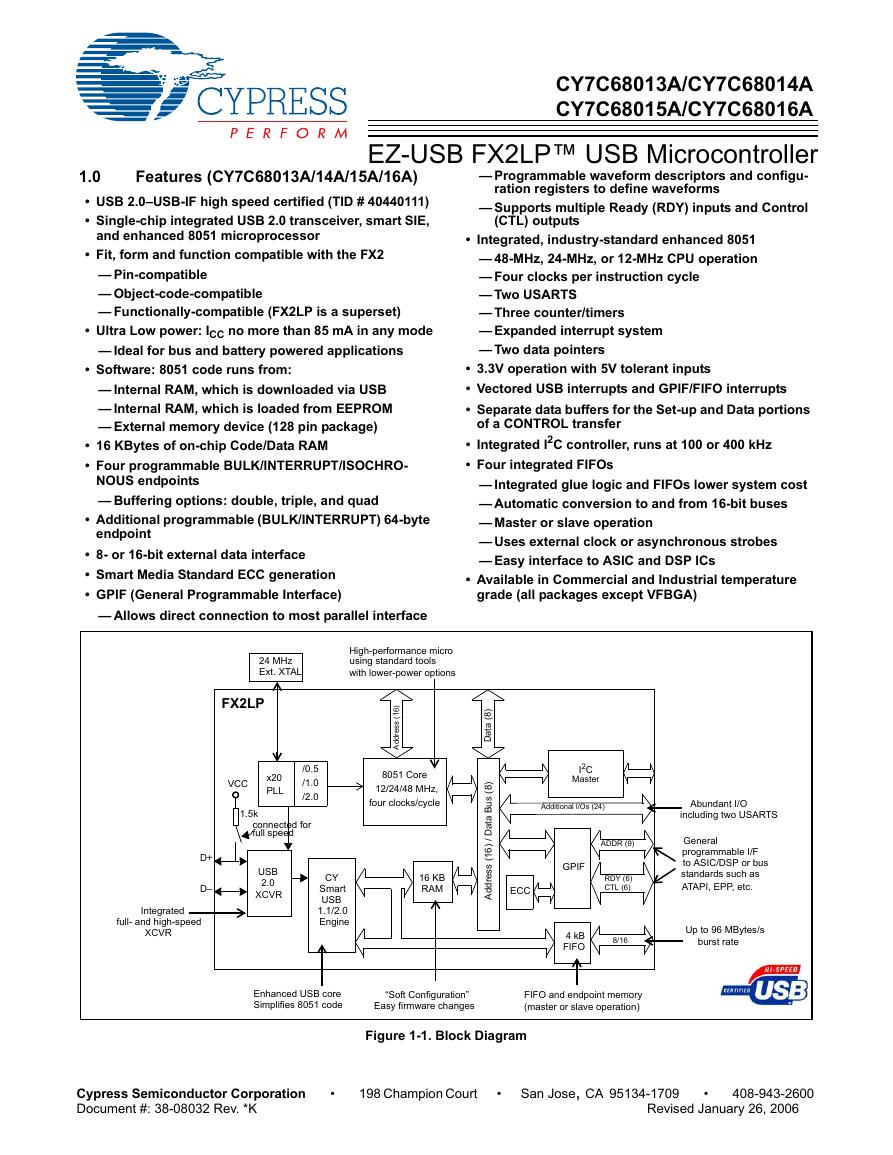 CY7C68013A(英文版)(CY7C68013A).pdf
CY7C68013A(英文版)(CY7C68013A).pdf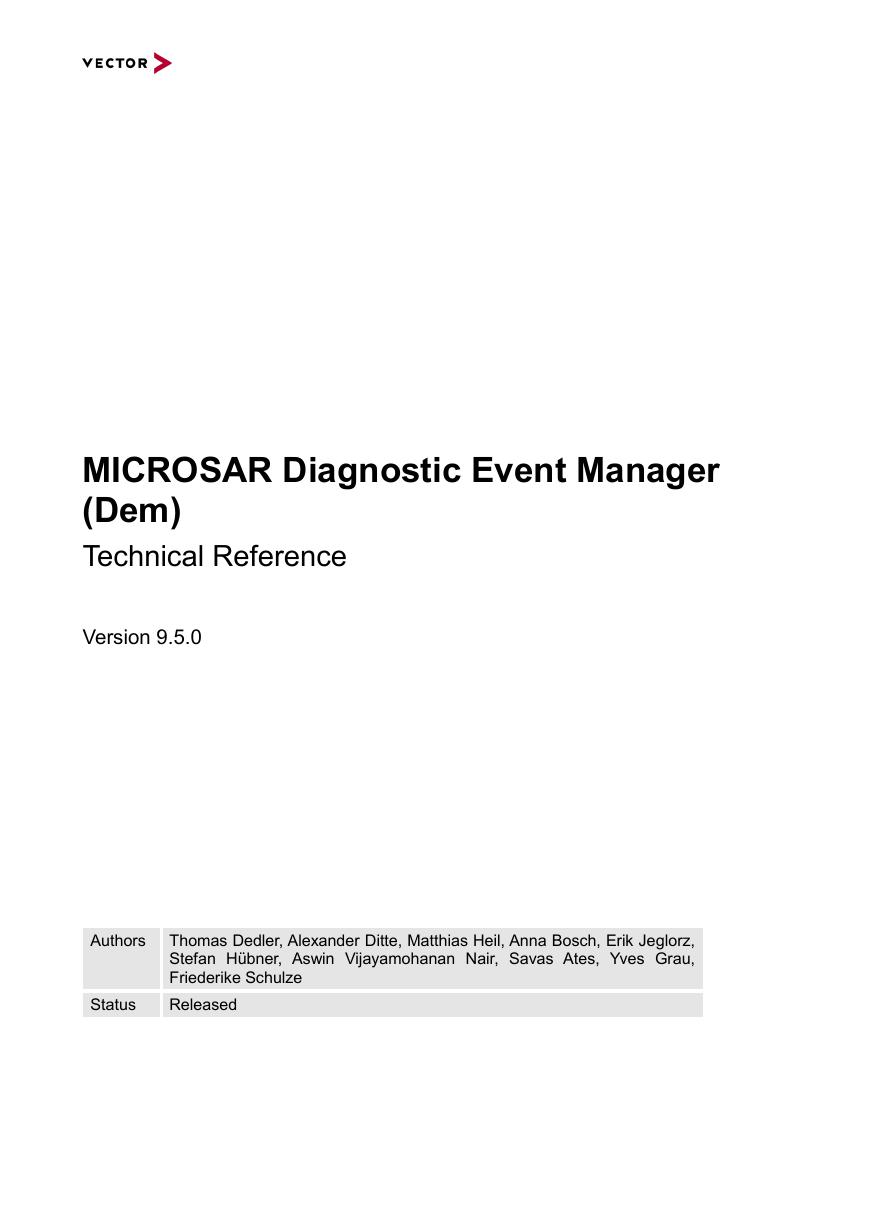 TechnicalReference_Dem.pdf
TechnicalReference_Dem.pdf